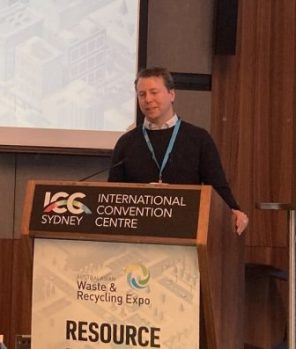Australia is set to fall short of landfill reduction targets contained in the federal government’s national action plan, a summit of government and industry leaders has heard.

The Federal government’s 2019 National Waste Policy Action Plan includes a set of targets including an 80 per cent average resource recovery rate from all waste streams by 2030, and a 50 per cent reduction of organics going to landfill.
The targets were agreed to by Australian environment ministers and ALGA in December 2018.
But in a keynote address to the Australasian Waste and Recycling Summit in Sydney on Wednesday, the managing director of resource recovery consultants MRA, Mike Ritchie, said “on current trajectories we’ve got no chance of getting there” in the next eight years.
He also slammed the states for lack of action, saying that despite signing up to the targets, no state has yet put forward a plan of how to get there.
Slight improvement but not enough
The NSW EPA’s new CEO, Tony Chappel, admitted the state government isn’t where it hoped to be in terms of the targets.
He released new figures revealing that NSW is currently at 66 per cent diversion, with only 44 per cent of municipal solid waste being diverted.
However, there had been a two per cent improvement between 2020-21, Mr Chappel said.
“It’s going in the right direction,” he said. “But it’s fair to say it’s not where the government’s targets hoped to be … and it’s obviously not where we need to be.”
It’s fair to say it’s not where the government’s targets hoped to be .. and obviously not where we need to be.”
EPA CEO Tony Chappel
Mr Ritchie said the two key targets of the action plan – 80 per cent diversion of all waste from landfill by 2030 and 50 per cent reduction in organic waste to landfill – were potentially achievable.
“But we’re going to have to do a bucketful of work to get even close to an 80 per cent diversion from landfill rate,” he said. “We will not achieve the 80 per cent on current trends and policies.”
Landfill increasing
Mr Ritchie says in 1996, Australia generated 22 million tonnes of waste and landfilled seven per cent of that. But even though diversion rates have risen since then, the nation is landfilling three times as much as it did 30 years ago.

He said there was an urgent need was harmonisation across the country as well as cost, policy and regulatory levers, and massive investment in recycling and recovery infrastructure.
“Waste to landfill is still growing nationally and it’s likely to continue to grow unless we move fast,” he said.
“The 80 per cent diversion means that we need to grow 18 million tonnes of additional recycling in the next eight years. That is twice the rate of growth of recycling infrastructure services of the last ten years. So we need to double the rate of investment in infrastructure and services.”
Mr Ritchie also said while all governments had signed up to the targets, not one single state has since developed a plan to get there and there wasn’t a single circular economy regulation anywhere in the country.
National Waste and Recycling Industry Council (NWRIC) CEO Rick Ralph said the conversation needed to be taken from within the sector to reach policy makers and the community.
“Aspirationally, the 80 per cent, we’re all on the same train,” he said. “The greatest challenge going forward is the social licence conversation.”





Leave a Reply